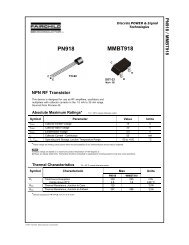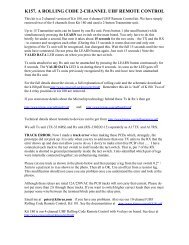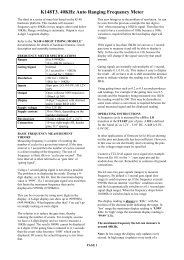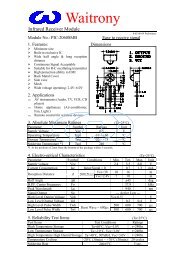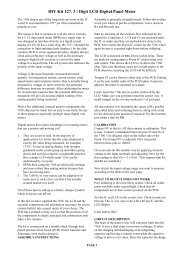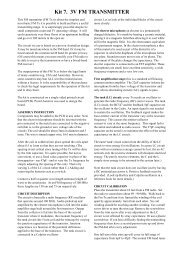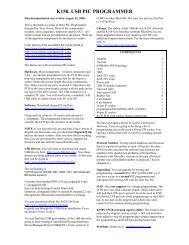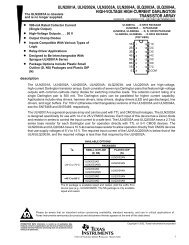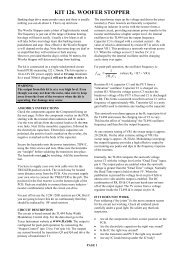DIY KIT 94. STEPPER MOTOR DRIVER - Kitsrus
DIY KIT 94. STEPPER MOTOR DRIVER - Kitsrus
DIY KIT 94. STEPPER MOTOR DRIVER - Kitsrus
Create successful ePaper yourself
Turn your PDF publications into a flip-book with our unique Google optimized e-Paper software.
<strong>DIY</strong> <strong>KIT</strong> <strong>94.</strong> <strong>STEPPER</strong> <strong>MOTOR</strong> <strong>DRIVER</strong><br />
This circuit illustrates the complex operations that can go<br />
on inside modern dedicated integrated circuits. The circuit<br />
uses a bi-directional digital rotary encoder from Bourn to<br />
step a unipolar stepper motor; one click on the encoder<br />
steps the stepper motor one step (or half a step as<br />
described below.) This discrete motion can of course then<br />
be geared up or down to suit your particular purpose. The<br />
stepper motor is not supplied in the kit. Six wire unipolar<br />
stepper motors are readily obtainable for a couple of $US.<br />
The kit is not designed for 4 wire, bipolar steppers.<br />
In this kit, we are using a preprogrammed PIC<br />
microcontroller (uC) and a dedicated stepping motor<br />
driver IC, UCN5804B to replace what would have<br />
formerly been a board full of discrete gates such as AND,<br />
OR, NOT, etc. followed by a set of power transistors.<br />
The microcontroller<br />
The PIC16C54 microcontroller takes the input from a<br />
mechanical encoder and converts it to two separate<br />
signals: pulse and direction. As the encoder is turned it<br />
generates two square waves which are in quadrature - 90<br />
degrees apart. By doing a bit of mathematical<br />
manipulation, the microcontroller then works out how far<br />
the encoder has turned and in what direction.<br />
Once the direction and magnitude of the rotation has been<br />
worked out in the uC, it is sent out as pulse and direction<br />
signals to pins 7 and 6, respectively of the UCN5804<br />
stepper motor driver IC.<br />
The Driver<br />
The 5804 stepper driver is one of those marvellous<br />
devices that makes life so easy you wonder how you<br />
managed to get along without it. There was a very good<br />
article on stepping motors and the use of the 5804 in<br />
Electronics Australia Oct & Nov ‘<strong>94.</strong> The Links page of<br />
our website (http://www.kitsrus.com) lists several online<br />
sources of information about stepper motors.<br />
The driver will operate six - wire motors at up to 35V and<br />
1.25A. The step input is to pin 7 and direction goes to pin<br />
6 of the 5804. Pins 9 and 10 on the PIC control one phase<br />
and half step operation, respectively. Pins 1 - 8 are the<br />
connections to the stepping motor. Five & eight wire<br />
steppers can be adapted to use this kit; see Kit 113<br />
documentation which can downloaded from our website.<br />
Half step and single/double phase refer to methods of<br />
operating stepping motors. In one phase operation only<br />
one coil attracts the rotor at a time. This is also referred to<br />
as wave drive. Alternately, two phase drive energises two<br />
adjacent phased in each rotor detent position giving much<br />
better torque and speed characteristics.<br />
Half step operation is a combination of one and two phase<br />
drives causing the rotor to take twice as many steps per<br />
revolution. For a more detailed explanation see the<br />
Allegro data sheet on the UCN5804 which can be got<br />
from Allegro (www.allegromicro.com) or from our own<br />
website. Kit 113 also has a more detailed discussion. The<br />
documentation for Kit 113 may also be downloaded from<br />
our website at http://www.kitsrus.com.<br />
Digital Contacting Rotary Encoder<br />
Also called Digital Panel Control, a Bit Switch, Grey<br />
switch or Digital Switch, rotary encoders provide a pair of<br />
digital Grey-coded signals that allow a uC to determine<br />
the speed & direction of the rotation of a shaft. (For<br />
example, a computer mouse uses two digital encoders to<br />
track the x & y axis movements of a ball in it.) The<br />
PIC16Cxx Applications Handbook by Parallax has a<br />
section (Section 4) on the details of these encoders. The<br />
advantage of the encoder is that it permits the direct entry<br />
of digitised analog data into a digital circuit without A/D<br />
conversion. The data sheet (zipped pdf file) of the ECW1J<br />
Bourne digital contacting encoder used in this kit can be<br />
obtained from out web page at<br />
http://www.kitsrus.com/soft.html<br />
The circuit<br />
There is surprisingly little to the circuit. The encoder input<br />
is to pins 17 and 18 of the micro and the pins are pulled<br />
high by R4 and R5 until grounded by the encoder. The<br />
supplied encoder is a 24 cycle type which will actually<br />
generate 96 pulses per revolution.<br />
The microcontroller is a PIC 16C54 and this is run using<br />
an RC oscillator as a clock input. The RC in question is<br />
C1 and R3 and the values chosen give a clock speed of<br />
about 3 MHZ. Note that simply changing R3 will raise or<br />
lower the clock speed and consequently speed up or slow<br />
down the motor. The source code is available for<br />
downloading from our website.<br />
Both the uC and the driver 5804 IC’s run on 5V and this<br />
is provided by a standard 78L05 regulator together with<br />
capacitors C2 - C4. Interestingly, the driver actually runs<br />
on 5V despite the fact that the motor side can handle up to<br />
35V.<br />
There is provision for continuous rotation of the stepping<br />
motor. Pin 11 of the PIC is pulled to ground by R6.<br />
Connecting this pin to 5V will result in the motor rotating<br />
at its maximum speed.<br />
It may seem strange to pull pins 1 and 2 of the uC up with<br />
R1 and R2, but there are good reasons for it. The software<br />
depends on these pins being high as they are part of port<br />
a which is the encoder input port. They are not connected<br />
directly to the 5V rail for a rather subtle reason: the port<br />
assignments are all done in software so that the relevant<br />
pin can be input or output. The problem is that when there<br />
is a bit of electrical noise around the port assignments can<br />
be corrupted resulting in, say, pin 1 trying to pull the<br />
supply rail down to ground. Exit one microcontroller.<br />
Construction and testing<br />
1
<strong>DIY</strong> <strong>KIT</strong> <strong>94.</strong> <strong>STEPPER</strong> <strong>MOTOR</strong> <strong>DRIVER</strong><br />
The voltage regulator and chip sockets are installed and<br />
the circuit is powered up. Check for correct voltages at the<br />
power supply pins of the micro and the driver.<br />
Put in all the resistors and power it all up again. Check<br />
that all the pins that are pulled up are at 5V and all the<br />
pulled down pins are at ground potential. Note to add the<br />
Link required situated between the two IC’s.<br />
The encoder has three pins. The center pin is the earth pin.<br />
Use some wire to connect the 3 pins to the 3 pin terminal<br />
block on the PCB. It does not matter which way around<br />
the X & Y terminals are connected.<br />
There are two SPDT switches on the board to select half<br />
step and one/two phase. Connecting pins 9 and 10 to G,<br />
ground, will give two phase drive. Note that connecting<br />
both to +V turns off the motor.<br />
Put in the driver IC and solder up the stepping motor leads<br />
to finish the job. If you are having trouble identifying the<br />
leads then get out your multimeter and set it to ohms.<br />
There should be two sets of three leads.<br />
Solder one center lead to pin 2 of the 5804 brought out to<br />
the 6-pin header and the other two leads A & B to pins 1<br />
and 3, the order is not important. The other center lead<br />
then goes to pin 7 and the remaining leads C & D go to<br />
pins 6 and 8.<br />
You should find that turning the encoder once will rotate<br />
the motor twice for two phase drive, assuming a 48 step<br />
motor. Connect the Continuous Rotation pads and the<br />
motor should spin happily.<br />
PARTS LIST - Kit 94<br />
78L05 regulator ................. Q1 .................................. 1<br />
16C54-RC/P PIC ............... IC1 ................................. 1<br />
UCN5804B IC ................... IC2 ................................. 1<br />
16 pin IC socket .................. ....................................... 1<br />
18 pin IC socket .................. ....................................... 1<br />
Bourne Rotary encoder ECW1J .................................. 1<br />
SPDT switch........................ ....................................... 2<br />
3 pole terminal block .......... ....................................... 1<br />
2 pole terminal block........... ....................................... 1<br />
6 wire harness/socket .......... ....................................... 1set<br />
Capacitors:<br />
15pF ceramic ....................... C1 .................................. 1<br />
100nF mono .2" pitch ......... C2 C4............................. 2<br />
1000uF/35V......................... C3 .................................. 1<br />
Resistors 5%, carbon film:<br />
12K ..................................... R1 R2 R6 ....................... 3<br />
5K6 .................................... R3 .................................. 1<br />
1K5 .................................... R4 R5............................. 2<br />
K94 PCB ............................. ....................................... 1<br />
Software<br />
The source code for Kit 94, the data sheet (pdf format) for<br />
the UCN5804 driver and the documentation for Kit113<br />
(giving more information on unipolar stepper motor<br />
connections & ballast resistors) is available on the<br />
software download page our website, http://kitsrus.com<br />
As the motor is spinning, try varying the supply voltage.<br />
This will make the motor run more roughly or smoothly.<br />
Stepping motors are very sensitive to supply voltage<br />
variations. Try the same thing while turning the encoder,<br />
you will quickly get a feel for stepping motor quirks.<br />
If It Does Not Work<br />
First check that the SPDT switches are not both in the +V<br />
position. That turns off the motor. Second check that the<br />
IC’s are in the correct way around. Finally the problems<br />
must be the connection of the stepper motor to the<br />
harness. A detailed explanation of how to get the correct<br />
connections is given in Kit 113 documentation. Make sure<br />
the pins A B C D from the stepper motor are matched with<br />
the overlay. The + common from each winding goes to<br />
pins 2 & 5 of the six-pin harness. See the schematic for a<br />
detailed connection pattern.<br />
Figure 1. Six wire stepper motor. Five & eight wire<br />
stepper motors can be wired to this form to be used with<br />
Kit <strong>94.</strong><br />
- - - - - - - - - - - - - - - - - - - - - -<br />
2
<strong>DIY</strong> <strong>KIT</strong> <strong>94.</strong> <strong>STEPPER</strong> <strong>MOTOR</strong> <strong>DRIVER</strong><br />
3



